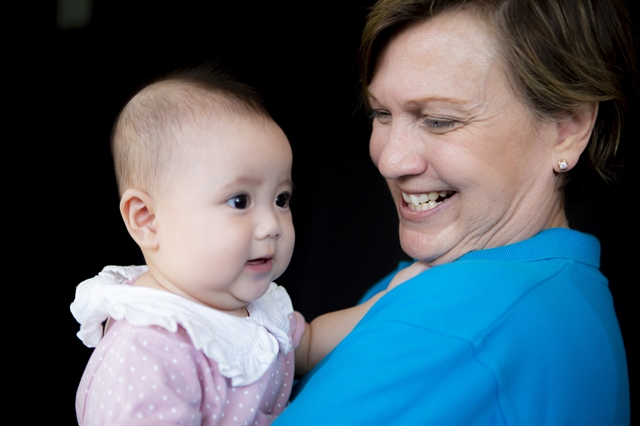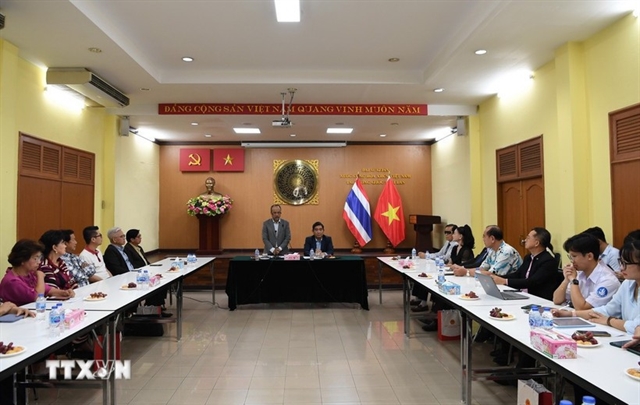 Society
Society


|
| UNICEF Representative in Việt Nam Rana Flowers poses with a baby girl. UNICEF has urged Việt Nam to have policies and laws to help children suffering from Severe Acute Malnutrition (SAM) in Việt Nam. Photo courtesy of UNICEF |
HÀ NỘI — Ninety per cent of the children suffering from Severe Acute Malnutrition (SAM) in Việt Nam remain untreated. There is a solution, and it only needs policies and laws to enable it, UNICEF Representative in Việt Nam Rana Flowers has said.
Speaking at the issue of SAM on Friday, Rana Flowers said SAM was the most lethal form of undernutrition and one of the top threats to child survival.
Around one in five deaths among children under five are attributed to this disease globally. At least 13.6 million children under five suffer from SAM. Tragically, a child in this condition is not a healthy child, making them more vulnerable to common illnesses.
She said that children with SAM are about 12 to 20 times more likely than healthy children to die of common illnesses like pneumonia and diarrhoea.
"How is this possible when SAM can be treated? And that is the challenge Việt Nam faces – how to introduce a practical, urgent solution to dramatically reduce the current 230,000 children in this country annually suffering from severe acute malnutrition? That is 230,000 children who are at least 12 times more likely to die of common illness, let alone the cost to the health system as the affected children are hospitalised," she said.
"It is treatable. It requires families with SAM children to have access to clinically formulated therapeutic products, which WHO and UNICEF approve," she stressed.
Globally, 25 countries, including Việt Nam's neighbour Cambodia, have included therapeutic products for the treatment of SAM in their national List of Essential Medicines.
To ensure that every child who has SAM receives treatment, irrespective of ethnicity or socioeconomic status, UNICEF urgently calls upon the Ministry of Health, the Government and the National Assembly to ensure that policies and laws, including the upcoming revision of Law on Medical Examination and Treatment to recognise SAM as a disease, identify approved therapeutic products available to treat SAM as medicines, and include treatment of SAM to be covered by health insurance.

|
| Hồ Thị Ngọc Hằng is six months old but weighs only five kilos. Photo courtesy of UNICEF |
Hồ Thị Ngọc Hằng is a six-month-old baby weighing only five kilos. Born at the weight of 2.4kg as a term baby, Hằng is the second child in a Cor ethnic minority family in Trà Giang Commune, Trà Bồng District of central Quảng Ngãi Province.
She was identified as suffering from severe acute malnutrition during the outreach and malnutrition screening supported by UNICEF and the National Institute of Nutrition (NIN) in the aftermath of the devastating storms of floods that struck central Việt Nam at the end of 2020.
Her mother, Hồ Thị Hoa, 35, breastfed her for the first six months. During a consultation with doctors, Hoa shared that her family rarely have meat or fish for meals as she and her husband are casual labourers and earn VNĐ150,000 (US$6.50) a day.
They often have rice with vegetables and salt. They don't have rice fields or farmland to cultivate.
The doctor advised Hoa to improve her meals with more nutritional food during breastfeeding so that her baby can benefit more from her breastmilk.
At the same time, UNICEF supports her baby with ready-to-use therapeutic food (RUTF) as the introduction of solid food since the baby is almost seven months old and will need nutrition and treatment to boost her condition. For small babies older than six months, the RUTF can be mixed with hot water to turn to liquid or with other soft food, such as porridge, mashed fruits or vegetables, twice a day.
"The treatment and care for severely acutely malnourished children require time and effort from families and the health care system. Hoa should feed her baby 5 to 6 meals a day, including breastmilk, nutritional food and therapeutic food," said Dr Vũ Văn Tân from the National Institute of Nutrition.
Rana Flowers said by making these concrete policy changes, Việt Nam would dramatically reduce the burden of severe acute malnutrition.
"The solutions are simple and have been proven effective around the world. Now is the time for Việt Nam to take the needed actions to ensure all children survive, thrive and develop to their full potential. It's time to get childhood back on track," she said.
By doing so, Việt Nam would better implement its obligations under the Convention on the Rights of the Child, ensure the achievement of relevant Sustainable Development Goal (SDG) targets set by Việt Nam, and follow the 2016 Law on Children, she added. — VNS




